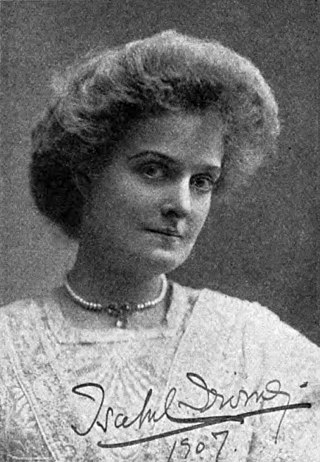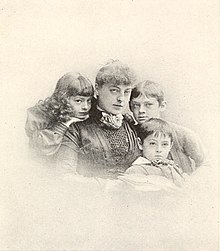
Lionel Barrymore was an American actor of stage, screen and radio as well as a film director. He won an Academy Award for Best Actor for his performance in A Free Soul (1931) and is known to modern audiences for the role of villainous Mr. Potter in Frank Capra's 1946 film It's a Wonderful Life.

John Barrymore was an American actor on stage, screen, and radio. A member of the Drew and Barrymore theatrical families, he initially tried to avoid the stage, and briefly attempted a career as an artist, but appeared on stage together with his father Maurice in 1900, and then his sister Ethel the following year. He began his career in 1903 and first gained attention as a stage actor in light comedy, then high drama, culminating in productions of Justice (1916), Richard III (1920), and Hamlet (1922); his portrayal of Hamlet led to him being called the "greatest living American tragedian".
The Barrymore family, and the related Drew family, form a British-American acting dynasty which traces its acting roots to the mid-19th century London stage. After migrating across the Atlantic Ocean to the United States, members of the family subsequently appeared in motion pictures, beginning with the silent film period of the 1890s to 1929 and then into the modern era of sound film.

Maude Ewing Adams Kiskadden, known professionally as Maude Adams, was an American actress and stage designer who achieved her greatest success as the character Peter Pan, first playing the role in the 1905 Broadway production of Peter Pan; or, The Boy Who Wouldn't Grow Up. Adams's personality appealed to a large audience and helped her become the most successful and highest-paid performer of her day, with a yearly income of more than $1 million during her peak.

John Drew Jr., commonly known as John Drew during his life, was an American stage actor noted for his roles in Shakespearean comedy, society drama, and light comedies. He was the eldest son of John Drew Sr., who had given up a blossoming career in whaling for acting, and Louisa Lane Drew, and the brother of Louisa Drew, Georgiana Drew, and Sidney Drew. As such, he was also the uncle of John, Ethel, and Lionel Barrymore, and also great-great-uncle to Drew Barrymore. He was considered to be the leading matinee idol of his day, but unlike most matinee idols Drew's acting ability was largely undisputed.

Dolores Costello was an American film actress who achieved her greatest success during the era of silent movies. She was nicknamed "The Goddess of the Silent Screen" by her first husband, the actor John Barrymore. She was the mother of John Drew Barrymore and grandmother of actress and talk show host Drew Barrymore.

Elsie Louise Ferguson was an American stage and film actress. Seen by some as an early feminist, she promoted suffrage, which she discussed in interviews, and supported animal rights.

Herbert Arthur Chamberlayne Blyth, known professionally by his stage name Maurice Barrymore, was an Indian-born British stage actor. He is the patriarch of the Barrymore acting family, and the father of John, Lionel and Ethel.

Louisa Lane Drew was an English-born famous British American actress and theatre owner. manager and an ancestor of the prominent Barrymore-Drew acting family. Professionally, she was often billed and known as Mrs. John Drew.

William Clyde Fitch was an American dramatist, the most popular writer for the Broadway stage of his time.

Georgiana Emma Drew, a.k.a.Georgie Drew Barrymore, was an American stage actress and comedian and a member of the Barrymore acting family.

Irene Fenwick was an American stage and silent film actress. She was married to Lionel Barrymore from 1923 until her death in 1936. Fenwick has several surviving feature films from her productions for the Kleine-Edison Feature Film Service, which also has numerous surviving shorts in the Library of Congress.

Ida Conquest was a leading lady of Broadway in the late 19th century and early 20th century.

Isabel Irving was an American stage actress.

The Nightingale, a drama film directed and written by Augustus Thomas in 1914, is a silent drama film, which Alco Film Corporation released. Ethel Barrymore makes her acting debut in this feature film, which Thomas wrote specifically for her. Thomas, famed as a Broadway playwright, was the best friend of Barrymore's father Maurice, and had known the actress since she was a child. As with many of Barrymore's films to come, the advertising for this film says the film is told in 'acts' as with a stage play, an effort to remind the audience of the star's status and preference for the legitimate stage. This film was long thought to be lost.

Louise Drew was an American stage actress.

Hattie Williams was an American stage actress, comedian and vocalist from Boston. She was a popular player in vaudeville and with Charles Frohman's theatrical company at the turn of the twentieth century and appeared often at his famous Empire Theatre, New York.

Ethel Barrymore was an American actress of stage, screen and radio. She came from a family of actors; she was the middle child of Maurice Barrymore and Georgie Drew Barrymore, and had two brothers, Lionel and John. Reluctant to pursue her parents' career, the loss of financial support following the death of Louisa Lane Drew, caused Barrymore to give up her dream of becoming a concert pianist and instead earn a living on the stage. Barrymore's first Broadway role, alongside her uncle John Drew, Jr., was in The Imprudent Young Couple (1895). She soon found success, particularly after an invitation from William Gillette to appear on stage in his 1897 London production of Secret Service. Barrymore was soon popular with English society, and she had a number of romantic suitors, including Laurence Irving, the dramatist. His father, Henry Irving, cast her in The Bells (1897) and Peter the Great (1898).

May Davenport Seymour Eckert (1883–1967) was an American stage actress descended from a long line of famous actors and later a patron of the arts scene in New York. She was the daughter of actor and stage manager William Gorman Seymour and actress May Marian Caroline Davenport. She had three siblings. Her maternal grandparents were E. L. Davenport and Fanny Vining Davenport, two famous mid-19th century actors. Her mother May Marian was a sister of famous 19th-century star Fanny Davenport and Hollywood actor Harry Davenport. May Eckert married William Stanley Eckert in 1908; one of their children was actress Anne Seymour who usually dropped her surname professionally.
Ethel Barrymore Colt was an American actress and producer and a soprano who sang in more than 100 concerts in the United States, Canada, and South America. She was a member of the ninth generation of the Barrymore acting family. Her obituary in The Washington Post described her as "a versatile and talented singer, actress and producer, playing dramatic roles on Broadway and in summer stock and singing in grand opera, operetta, musical comedy and on the concert stage."



























